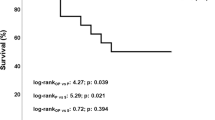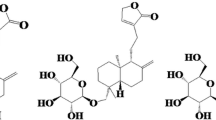Abstract
To investigate the significance of mast cells in the popliteal lymph node during the development of an inflammatory response, rats were inoculated with 12×107 colony-forming units ofStaphylococcus aureus in the hind foot pad. Numerical changes in mast cells were then measured in the corresponding popliteal lymph node. Six days after inoculation, despite the enlargement of the responding lymph node, a marked decrease in granulated mast cell number, relative to the contralateral node, was observed in the cortical and medullary compartments. Popliteal lymph nodes from rats treated with compound 48/80 and then inoculated withS. aureus showed a higher cortical and medullary hypertrophic response and a significant increase in degranulated/weakly basophilic mast cell number in the lymph node tissue. The findings suggest that (1)Staphylococcus aureus induces a reduction in granulated mast cell number in the cortical and medullary compartments of regional lymph nodes; (2) pretreatment with compound 48/80 appears to contribute to the lymphoid cell proliferation and the hypertrophic response of lymph nodes induced byS. aureus; and (3) granulated mast cells have a regulatory role on lymphoid cell proliferation.
Similar content being viewed by others
References
J. N. Sheagren,Staphylococcus aureus: The persistent pathogen, Part 1. New Engl. J. Med.310, 1368–1273 (1984).
J. N. Sheagren,Staphylococcus aureus: The persistent pathogen, Part 2. New Engl. J. Med.310, 1437–1442 (1984).
R. L. Kerlin, D. L. Watson and I. G. Colditz,Inflammatory and immunological responses in skin and peripheral lymph of sheep following intracutaneous injection of Staphylococcus aureus. Inflammation11, 175–188 (1987).
M. T. Drayson,The entry of lymphocytes into stimulated lymph nodes: The site of selection of alloantigen-specific cells. Transplantation41, 745–751 (1986).
M. T. Drayson, M. E. Smith and W. L. Ford,The sequence of changes in blood flow and lymphocyte influx to stimulated rat lymph nodes. Immunology44, 125–133 (1981).
P. G. Herman, I. Yamamoto and H. Z. Mellins,Blood microcirculation in the lymph node during the primary immune response. J. Exp. Med.136, 697–714 (1972).
N. D. Anderson, A. O. Anderson and R. G. Wyllie,Microvascular changes in lymph nodes draining skin allografts. Am. J. Pathol.81, 131–160 (1975).
B. A. Morlock, L. Spero and A. D. Johnson,Mitogenic activity of staphylococcal exfoliative toxin. Infect. Immun.30, 381–384 (1980).
B. G. Smith and N. M. Johnson,The effect of staphylococcal enterotoxins on the primary in vitro immune response. J. Immunol.115, 575–578 (1975).
P. Marrack, M. Blackman, E. Krshnir and J. Kappler,The toxicity of staphylococcal enterotoxin B in mice is mediated by T cells. J. Exp. Med.171, 455–464 (1990).
B. L. Rellahan, L. A. Jones, A. M. Kruisbeek, A. M. Fry and L. A. Matis,In vivo induction of anergy in peripheral V beta 8 positive T cells by staphylococcal enterotoxin B. J. Exp. Med.172, 1091–1100 (1990).
S. Takei, Y. Arora and S. M. Walker,Intravenous immunoglobulin contains specific antibodies inhibitory to activation of T cells by staphylococcal toxin superantigens. J. Clin. Invest.91, 602–607 (1993).
H. R. MacDonald, S. Baschieri and R. K. Lees,Clonal expansion precedes anergy and death of V β8+ peripheral T cells responding to staphylococcal enterotoxin B in vivo. Eur. J. Immunol.21, 1963–1966 (1991).
S. J. Galli,New insights into “the riddle of the mast cells”: Microenvironmental regulation of mast cell development and phenotypic heterogeneity. Lab. Invest.62, 5–33 (1990).
S. Wasserman,The mast cell and the inflammatory response. InThe Mast Cell: Its Role in Health and Disease. (Eds. J. Pepys and A. M. Edwards) pp. 9–20, Pitman Medical Publishing, England 1979.
D. D. Metcalfe and M. Kaliner,Mast cells and basophils. InCellular Functions in Immunity and Inflammation. (Eds. J. J. Oppenheim, D. L. Rosenstreich and M. Potter) pp. 301–322, Elsevier, New York 1981.
J. Bienestock, M. Tomioka, R. Stead, P. Ernst, M. Jordana, J. Gauldie, J. Dolovich and J. Denburg,Mast cell involvement in various inflammatory processes. Am. Rev. Respir. Dis.135, S5-S8 (1987).
A. N. Roberts,Early mast cell responses in mouse popliteal lymph nodes to localized primary antigenic stimuli. J. Immunol.105, 187–192 (1970).
R. Keller, H. Cottier and M. W. Hess,Mast cell responses in mesenteric lymph nodes to infection of rats with the nematode Nippostrongylus brasiliensis. Immunology27, 1039–1044 (1974).
A. D. Befus, N. Johnston and J. Bienenstock,Nippostrongylus brasilienseis: Mast cells and histamine levels in tissues of infected and normal rats. Exp. Parasitol.48, 1–8 (1979).
L. Thompson-Snipes, V. Dhar, M. W. Bond, T. R. Mosmann, K. W. Moore and D. Rennick,Interleukin-10: A novel stimulatory factor for mast cells and their progenitors. J. Exp. Med.173, 507–510 (1991).
K. W. Moore, A. O'Garra, R. W. Malefyt, P. Vieira and T. R. Mosmann,Interleukin-10. Ann. Rev. Immunol.11, 165–190 (1993).
J. R. Gordon, P. R. Burd and S. J. Galli,Mast cells as source of multifunctional cytokines. Immunol. Today11, 458–464 (1990).
J. N. Ihle, J. Keller, S. Oroszlan, L. E. Henderson, T. D. Copeland, F. Fitch, M. B. Prystowsky, E. Goldwasser, J. W. Schrader, E. Palaszynski, M. Dy and B. Lebel,Biologic properties of homogenous interleukin 31. Demonstration of WEHI-3 growth factor activity, mast cell growth factor activity, P cell-stimulating factor activity, colony-stimulating factor activity, and histamine-producing cell-stimulating factor activity. J. Immunol.131, 282–287 (1983).
Y. Hamaguchi, Y. Kanakura, J. Fujita, S.-I. Takeda, T. Nakano, S. Tarui, T. Honjo and Y. Kitamura,Interleukin 4 as an essential factor for in vivo clonal growth of murine connective tissue-type mast cells. J. Exp. Med.165, 268–273 (1987).
R. B. Bressler, H. L. Thompson, J. M. Keffer and D. D. Metcalfe,Inhibition of the growth of IL 3-dependent mast cells from murine bone marrow by recombinant granulocyte macrophage-colony-stimulating factor. J. Immunol.143, 135–139 (1989).
M. Takagi, K. Koike and T. Nakahata,Antiproliferative effect of IFN-γ on proliferation of mouse connective tissue-type mast cells. J. Immunol.145, 1880–1884 (1990).
M. A. Kelsall and E. D. Crabb, Lymphocytes and Mast Cells, pp. 56–83, Wilkians & Wilkins, Baltimore 1959.
G. Gomori,Aldehyde-fucsin: A new stain for elastic tissue. Am. J. Clin. Pathol.20, 665–666 (1950).
P. A. Shore, A. Burkhalter and V. H. Cohn, Jr.,A method for the fluorometric assay of histamine in tissues. J. Pharmacol. Exp. Ther.127, 182–186 (1959).
J. C. Gomes and F. L. Pearce,Comparative studies on the effect of non-steroidal anti-inflammatory drugs (NSAID) on histamine release from mast cells of the rat and guinea pig. Agents and Actions24, 266–271 (1988).
C. J. Early and B. E. Leonard,Isolation and assay of noradrenaline, dopamine, 5-hydroxytryptamine, and several metabolites from brain tissue using disposable bio-rad columns packed with sephadex G-10. J. Pharmacol. Meth.1, 67–79 (1978).
J. F. Riley and G. B. West,Tissue mast cells. Studies with a histamine-liberator of low toxicity (compound48/80). J. Pathol. Bact.69, 269–282 (1955).
K. Wlodarsk, G. Rychlic and S. Mazur,Lymphatic mast cells in response to in vitro stimulation by non-specific T-cell mitogens. Immunology55, 311–315 (1985).
R. C. Mahapatro and H. M. Bowers,Distribution of mast cells in the axillary lymph nodes of breast cancer patients. Cancer44, 592–597 (1979).
G. Sainte-Marie and F. S. Peng,Mast cells and fibrosis in compartments of lymph nodes of normal, gnotobiotic, and athymic rats. Cell. Tissue Res.261, 1–15 (1990).
M. M. Khan, S. Strober and K. L. Melmon,Regulatory effects of mast cells on lymphoid cells: The role of histamine type 1 receptors in the interactions between mast cells, helper T cells and natural suppressor cells. Cellular Immunol.103, 41–53 (1986).
M. Z. White and M. A. Kaliner,Histamine. InInflammation Basic Principles and Clinical Correlates. (Eds. J. I. Gallin, I. M. Goldstein and R. Snyderman) pp. 169–193, Raven Press, New York 1988.
K. L. Melmon, R. E. Rocklin and R. P. Rosenkranz,Autacoids as modulators of the inflammatory and immune response. Am. J. Med.71, 100–106 (1981).
L. Stanciu,Immunomodulation by histamine. Ann. Biol. Clin.48, 623–625 (1990).
J. R. Gordon and S. J. Galli,Mast cells as a source of both preformed and immunologically inducible TNF-α/cachectin. Nature346, 274–276 (1990).
J. D.-E. Young, C.-C. Liu, G. Butler, Z. A. Cohn and S. J. Galli,Identification, purification, and characterization of a mast cell-associated cytolytic factor related to tumor necrosis factor. Proc. Natl. Acad. Sci. USA84, 9175–9179 (1987).
L. Enerbäck and G. B. Löwhagen,Long term increase of mucosal mast cells in the rat induced by administration of compound 48/80. Cell Tissue Res.198, 209–215 (1979).
L. Enerbäch, G. B. Löwhagen, O. Löwhagen and U. Wingren,The effect of polymyxin B and some mast cell constituents on mucosal mast cells in the duodenum of the rat. Cell Tissue Res.214, 239–246 (1981).
J. S. Marshall, R. H. Stead, C. McSharry, L. Nielsen and J. Bienenstock,The role of mast cell degranulation products in mast cell hyperplasia. I. Mechanism of action of nerve growth factor. J. Immunol.144, 1886–1892 (1990).
K. Jozaki, A. Kuriu, N. Waki, S. Adachi, A. Yamatodani, S. Tarui and Y. Kitamura,Proliferative potential of murine peritaneal mast cells after degranulation induced by compound 48/80, substance P, tetradecanoylphorbol acetate, or calcium ionophore A23187. J. Immunol.145, 4252–4256 (1990).
Author information
Authors and Affiliations
Rights and permissions
About this article
Cite this article
Sudo, L.S., Betti, F., Hanada, S. et al. Lymphatic mast cell response and effect of compound 48/80 on popliteal lymph node reaction in rats following intracutaneous injection ofStaphylococcus aureus . Agents and Actions 42, 135–140 (1994). https://doi.org/10.1007/BF01983479
Received:
Accepted:
Issue Date:
DOI: https://doi.org/10.1007/BF01983479




